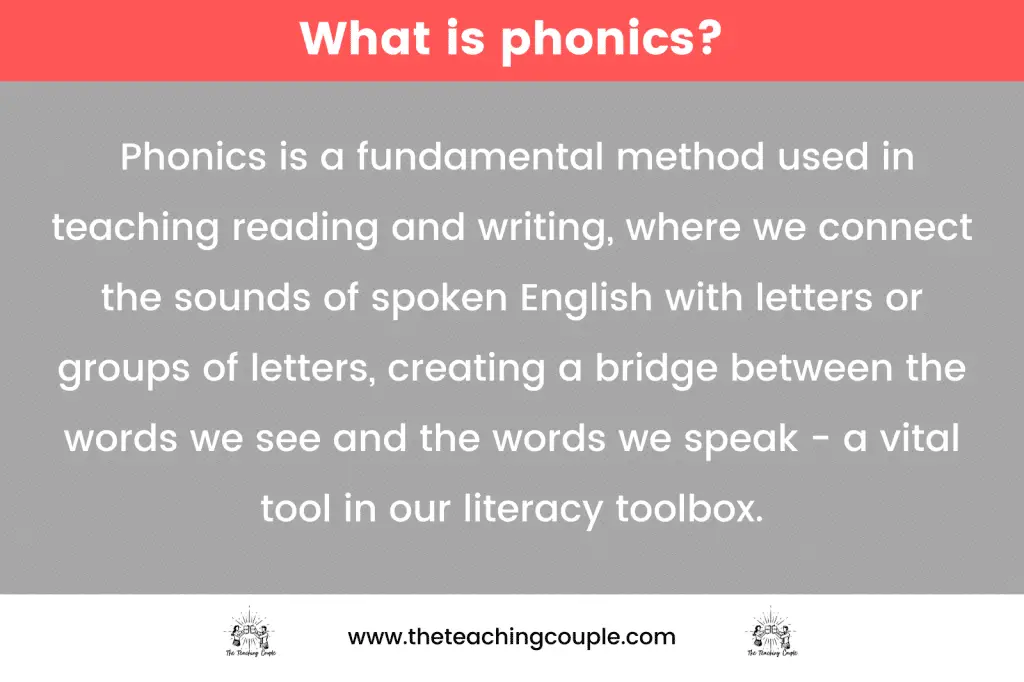Do you ever wonder why your one-year-old babbles in a language all their own? Why do they seem to be fascinated by the sounds around them? It’s because they’re beginning to explore the world of phonics!
Phonics, the study of sounds and how they associate with letters, is an essential stepping stone in your child’s journey towards language mastery.
Phonics for one-year-olds may seem like a daunting concept. After all, they’re just starting to recognize sounds, let alone connect them with written words.
But here’s the exciting part: introducing phonics at this tender age can ignite a love for learning, fuel curiosity, and lay a strong foundation for future reading skills.
In this guide, we’ll demystify the world of phonics for our youngest learners. We’ll share engaging, age-appropriate activities that introduce sounds in a fun, playful manner.
We’ll provide practical tips on incorporating phonics into your daily routines. And most importantly, we’ll show you how to make learning an enjoyable journey that you and your little one will cherish.
Related: For more, check out our article on whether Phonics and Phonetics Are The Same?

The World of Phonics For One Year Olds
Phonics and Its Role in Language Development
Are you familiar with the term ‘phonics’? If not, let’s delve into it together. Phonics is a method used for teaching reading and writing by developing learners’ phonemic awareness—the ability to hear, identify, and manipulate phonemes, the smallest units of sound.
It plays a crucial role in language development, serving as the building blocks of words.
Why, you might ask? Well, by recognising the sounds that makeup words, children can start to match these sounds to letters, and voila! They begin to decode the written language, a skill as magical as it sounds.
Related: For more, check out our article on Why We Do The Phonics Screen Check here.
Importance of Phonics in Developing Reading Skills
So, how does phonics enhance reading skills? Picture this: a child, armed with phonetic knowledge, encounters a new word.
Instead of feeling overwhelmed, they break the word down into its sounds, then blend these sounds back together to pronounce the word. This process, known as synthetic phonics, empowers them to tackle even the most daunting words.
Phonics not only improves reading accuracy but also boosts reading fluency, comprehension, and spelling. It’s like giving your child a key to a vast library filled with books waiting to be explored!
Related: For more, check out our article on Phonics and Dyslexia here.
How Phonics Can Ignite a Love for Learning and Fuel Curiosity
Can learning phonics really make a difference to a child’s attitude towards learning, you wonder? Absolutely! Once children understand the phonetic code, their confidence soars.
They’re no longer merely passive receivers of information but active participants in their own learning journey.
Imagine the joy and excitement a child feels when they independently read a sentence for the first time. That’s the power of phonics—it ignites a love for learning and fuels curiosity.
And who knows where this newfound curiosity might lead? Perhaps to a lifelong passion for books, a knack for storytelling, or an insatiable desire to know more about the world. That’s the beauty of it: the possibilities are endless.
Age-Appropriate Activities for Introducing Phonics
When it comes to introducing phonics to one-year-olds, we’re not talking about worksheets and drills.
Instead, we’re focusing on playful, engaging activities that captivate their curiosity and make learning sounds an enjoyable experience. Here are some age-appropriate activities to get you started:
- Sound Imitation Games: Mimic different sounds around the house or from nature and encourage your child to imitate them. This could be anything from the ‘buzz’ of a bee to the ‘tick-tock’ of a clock.
- Singing Nursery Rhymes: Songs like ‘Old MacDonald Had a Farm’ or ‘The Wheels on the Bus’ introduce a variety of sounds in a fun, musical context.
- Reading Aloud: Choose books with lots of sounds and interesting characters. Make sure to emphasize the sounds as you read.
- Interactive Toys: Use toys that make different sounds. This could be a toy phone, a musical instrument, or a stuffed animal that ‘talks.
Instructions on How to Conduct These Activities
Now that we’ve got our list, let’s dive into how to conduct these activities. Remember, the goal here is not perfection, but exploration and enjoyment.
For sound imitation games, start by making a sound and then encourage your child to mimic it.
Be patient and give them time to process and respond. For singing nursery rhymes, don’t worry if you’re not a great singer. It’s all about having fun and making sounds together!
When reading aloud, choose a quiet, comfortable space where your child can focus on the story and the sounds. And finally, for interactive toys, show your child how to use the toy to make the sound, then encourage them to try it themselves.
Tips for Making These Activities Fun and Enjoyable for One-Year-Olds
Ready to make these activities even more fun? Here are some tips:
- Keep It Short and Sweet: One-year-olds have short attention spans, so keep activities brief and to the point.
- Be Enthusiastic: Show excitement when your child successfully imitates a sound. Your enthusiasm will motivate them to keep trying!
- Mix It Up: Variety is the spice of life, especially for curious one-year-olds. Alternate between different activities to keep things fresh and exciting.
- Follow Their Lead: If your child shows interest in a particular sound or activity, spend more time on it. Let their curiosity guide your phonics journey!
Remember, introducing phonics at this age should be an enjoyable experience for both you and your child. Happy exploring!
Incorporating Phonics into Daily Routines
Are you wondering how to integrate phonics learning into your daily routines seamlessly? It’s simpler than you might think! Here are a few practical tips:
- Morning Chats: Start the day with a fun sound check. Ask your child what sounds they can hear as they wake up – perhaps the ‘chirp’ of a bird or the ‘sizzle’ of breakfast cooking.
- Story Time: Turn your bedtime stories into phonics lessons by emphasizing the sounds of the characters or actions in the book.
- Mealtime Games: During meals, play games where you and your child take turns making different sounds.
- Outdoor Adventures: Use your daily walks or trips to the park to explore and mimic the sounds of nature.
Examples of Everyday Situations Where Phonics Can Be Introduced
Now that we’ve covered some tips let’s dive into specific examples of everyday situations where you can introduce phonics:
- Grocery Shopping: While picking out fruits and vegetables, emphasize the initial sound of each item. For instance, ‘b’ for banana or ‘t’ for tomato.
- Laundry Time: As you sort clothes, talk about the ‘swish’ sound of the washing machine or the ‘flap’ sound of clothes on the line.
- Car Journeys: Make the most of travel time by playing ‘I Spy’, but instead of colours or objects, use sounds. For example, “I spy with my little eye, something that begins with ‘ss’.”
Advice on Maintaining Consistency in Teaching Phonics
Consistency is key when it comes to teaching phonics. But how do you maintain it without turning learning into a chore? Here’s some advice:
- Regularly Incorporate Phonics into Activities: Make phonics a regular part of your child’s day by incorporating it into activities they enjoy.
- Stay Patient: Remember, learning takes time. Don’t rush your child – let them learn at their own pace.
- Keep It Fun: Keep the mood light and playful. If your child enjoys themselves, they’re more likely to engage with the learning process.
With these tips and examples in hand, you’re well on your way to creating a daily routine that not only teaches phonics but also fosters a love of learning. Happy teaching!
Making Learning an Enjoyable Journey
Strategies for Making Phonics Learning an Enjoyable Process
Phonics doesn’t have to be a dry, rigid subject. It can be one of the most fun and engaging parts of your child’s day! But how can we ensure this happy scenario? Here are some strategies:
- Gamify Phonics: Who said learning can’t be fun? Turn phonics into a game with activities like sound bingo or phonics treasure hunt.
- Use Interactive Tools: Bring in colorful flashcards, sound-matching puzzles, and interactive online resources to add a dash of excitement to phonics lessons.
- Incorporate Storytelling: Use stories to introduce new sounds. This not only makes learning more engaging but also helps children remember the sounds better.
- Follow Their Interests: If your child loves dinosaurs, use dinosaur-themed books or games to teach phonics. Tailoring the learning process to their interests will make it much more enjoyable.
Ways to Celebrate Progress and Achievements in Phonics Learning
Every step forward in your child’s phonics journey is worth celebrating. It boosts their confidence and motivates them to keep going.
So, how can you celebrate these achievements?
- Create a Phonics Progress Chart: Visualize their progress with a fun chart where they can add a sticker or a star every time they master a new sound.
- Celebrate ‘Sound Days’: Dedicate a day to celebrate the mastery of a particular sound. You could incorporate this sound into various activities throughout the day.
- Share Their Success: Share your child’s achievements with family members or friends. The added praise and encouragement will make them feel proud and motivated.
Conclusion
As we’ve explored throughout this guide, introducing phonics to one-year-olds is more than just an educational endeavor—it’s a vital step in their development.
It lays the groundwork for future literacy skills, fosters a love for learning, and opens up a world of curiosity and discovery.
By integrating phonics into daily routines, making learning fun and engaging, and celebrating each small achievement, we’re not just teaching sounds; we’re nurturing confident, eager learners.
This journey might be filled with challenges, but remember—the rewards are immense.
Now that you’re equipped with practical strategies, exciting activities, and a better understanding of the importance of phonics, it’s time to take the first step on this exciting journey.
Remember, you don’t have to be an expert to teach your child—you just need to be willing to explore, learn, and grow alongside them.
So why wait? Dive in, start playing with sounds, and discover the joy of phonics learning with your child. This journey will not only strengthen their cognitive skills but also create a treasure trove of shared memories.
As you embark on this adventure, remember that every ‘b’, ‘p’, or ‘s’ sound mastered is a stepping stone towards a lifelong love for learning. Let’s start this journey today!

